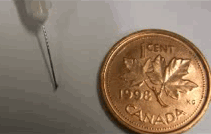
Restoring eyesight and healing brains: how hydrogels can boost the work of stem cells
Published: May 14, 2015
It's a discovery that, in early lab trials, has been shown to partially reverse blindness and help the brain recover from stroke.
Using a gel-like biomaterial called a hydrogel, University of Toronto scientists and engineers have made a breakthrough in cell transplantation that keeps cells alive and helps them integrate better into tissue.
Led by «—◊”÷Ī≤• professors and , together with Professor of the department of surgery, the team encased stem cells in a hydrogel ‚Äď and found it boosted the cells' healing abilities when transplanted into both the eye and the brain. These findings are part of an ongoing effort at «—◊”÷Ī≤• to develop new therapies to repair nerve damage caused by a disease or injury.
Conducted through the «—◊”÷Ī≤•‚Äôs , their research was published in the May 14 issue of , the official scientific journal of the International Society for Stem Cell Research.
Stem cells hold great therapeutic promise because of their ability to turn into any cell type in the body, including their potential to generate replacement tissues and organs. While scientists are adept at growing stem cells in a lab dish, once these cells are on their own ‚Äď transplanted into a desired spot in the body ‚Äď they have trouble thriving. The new environment is complex and poorly understood, and implanted stem cells often die or don‚Äôt integrate properly into the surrounding tissue.
Shoichet, a bioengineer who recently won , and her team created the hydrogel several years ago as a kind of a bubble wrap to hold cells together during transport and delivery into a transplant site.
‚ÄúThis study goes one step further, showing that the hydrogels do more than just hold stem cells together; they directly promote stem cell survival and integration. This brings stem-cell based therapy closer to reality,‚ÄĚ said Shoichet, a professor whose affiliations span the Donnelly Centre, the and the at «—◊”÷Ī≤•.
Partially restoring vision
In addition to examining how the stem cells benefit from life in hydrogels, the researchers also showed that these new cells could help restore function that was lost due to damage or disease.
One part of the Stem Cell Reports study involved the team injecting hydrogel-encapsulated photoreceptors, grown from stem cells, into the eyes of blind mice. Photoreceptors are the light-sensing cells responsible for vision in the eye. With increased cell survival and integration in the stem cells, they were able to partially restore vision.
‚ÄúAfter cell transplantation, our measurements showed that mice with previously no visual function regained approximately 15 per cent of their pupillary response. Their eyes are beginning to detect light and respond appropriately,‚ÄĚ said Dr. , an expert in stem cell biology and regenerative medicine for retinal degenerative disease, who led this part of the study.
 Ballios’ background as an engineer stimulated his interest in biomaterial-based approaches to therapy in the eye. He recently completed his MD and PhD under the supervision of Shoichet and van der Kooy, and he’ll be continuing his medical training as an ophthalmologist, hoping to apply some of his research insights in the clinic one day.
Ballios’ background as an engineer stimulated his interest in biomaterial-based approaches to therapy in the eye. He recently completed his MD and PhD under the supervision of Shoichet and van der Kooy, and he’ll be continuing his medical training as an ophthalmologist, hoping to apply some of his research insights in the clinic one day.
Repairing the brain after strokes
In another part of the study, , a postdoctoral fellow in both Shoichet’s and Morshead’s labs, injected the stem cells into the brains of mice who had recently suffered strokes. (Image at right.)
‚ÄúAfter transplantation, within weeks we started seeing improvements in the mice‚Äôs motor coordination,‚ÄĚ said Cooke.
His team now wants to carry out similar experiments in larger animals, such as rats, who have larger brains that are better suited for behavioral tests, to further investigate how stem cell transplants can help heal a stroke injury.
Advancing stem-cell based therapies
Leveraging engineering techniques ‚Äď such as the design and manufacture of new biomaterials ‚Äď to develop new stem-cell based therapies using hydrogels has always been on Shoichet‚Äôs mind.
‚ÄúI always think that in engineering our raison d‚Äô√™tre is to advance knowledge towards translation,‚ÄĚ said Shoichet.
Because the hydrogel could boost cell survival in two different parts of the nervous system, the eye and the brain, it could potentially be used in transplants across many different body sites. Another advantage of the hydrogel is that, once it has delivered cells to a desired place, it dissolves and is reabsorbed by the body within a few weeks.
This remarkable material has only two components ‚Äď methylcellulose that forms a gel and holds the cells together, and hyaluronan, which keeps the cells alive.
‚ÄúThrough this physical blend of two materials we are getting the best of both worlds,‚ÄĚ said Shoichet.





